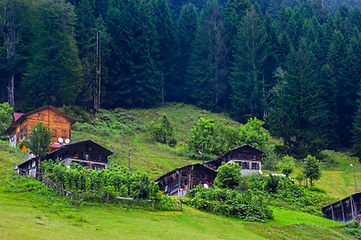

Basins and Water Resources
Watershed Restoration in the Western Highlands


Key details
Location:
North West & South West Regions
Duration:
Start May 2022 End August 2032
Budget:
$ 50,000
Project leader:
Mr Ndi Thomas
Project Code:
CAM/2023/163
The Western Highlands of Cameroon, which includes parts of the North-West and South-West Regions, is a region characterized by rich biodiversity, fertile volcanic soils, and numerous rivers and streams. However, this area faces significant challenges such as deforestation, soil erosion, land degradation, and water scarcity. These challenges have led to reduced agricultural productivity, loss of biodiversity, and altered water cycles, making watershed restoration a key priority for sustainable environmental and socio-economic development.
Objective of Watershed Restoration
The goal of watershed restoration in the Western Highlands is to rehabilitate and restore the integrity of the region’s watersheds to improve water quality and quantity, enhance biodiversity, prevent soil erosion, and promote sustainable land management practices. Restoring watersheds will also increase the resilience of the region to climate change impacts, such as flooding, droughts, and the shifting of rainfall patterns.
Key Goals of Watershed Restoration in the Western Highlands
-
Reduce pollution and sedimentation in rivers and streams, ensuring clean and safe water for domestic use, agriculture, and ecosystems.
-
Mitigate the effects of deforestation, overgrazing, and unsustainable farming practices by stabilizing the land and preventing soil erosion.
-
Promote sustainable farming practices that enhance soil fertility and improve crop yields while reducing dependence on harmful agricultural practices.
-
Ensure a more reliable and sustainable water supply for communities, farmers, and ecosystems, especially in dry seasons.
-
Protect and restore the natural vegetation, forests, wetlands, and wildlife in the watershed areas to improve ecosystem services such as water filtration, carbon sequestration, and habitat restoration.
-
Involve local communities in the planning, implementation, and maintenance of watershed restoration activities, empowering them to become stewards of their natural resources.
Key Strategies for Watershed Restoration in the Western Highlands
Reforestation and Afforestation
-
Replanting native tree species and restoring degraded forest areas within watersheds can significantly improve soil stability, enhance water infiltration, and promote biodiversity. Indigenous trees that are drought-resistant and climate-adapted should be prioritized.
-
Agroforestry Systems: Encouraging agroforestry practices, where trees and crops are integrated, can help restore degraded lands, improve soil fertility, and reduce runoff. Agroforestry systems also provide additional income sources for farmers through the harvest of timber, fruit, and non-timber forest products.
-
Community Nurseries: Establish community-based nurseries to produce indigenous tree seedlings that can be used for reforestation and afforestation efforts.
Soil and Water Conservation Techniques
-
Constructing terraces on steep slopes can significantly reduce soil erosion by slowing water runoff, allowing water to soak into the soil and improving soil fertility. This technique is particularly effective in the highland areas where the slopes are prone to erosion.
-
Implementing contour plowing along the natural contours of the land helps reduce water runoff and soil erosion. This practice also promotes better water retention and soil fertility.
-
Encouraging the use of organic mulches and cover crops can help protect the soil, improve water retention, and reduce evaporation losses. This practice also adds organic matter to the soil, enhancing soil fertility and structure.
Restoration of Riparian Zones and Wetlands
-
Planting trees and vegetation along riverbanks and streams is crucial to prevent soil erosion, filter water, and provide habitat for wildlife. Riparian vegetation also acts as a natural buffer against flooding and helps maintain water quality by trapping sediments and nutrients.
-
Restoring degraded wetlands can improve water retention, reduce flooding, and enhance biodiversity. Wetlands also serve as natural filtration systems, improving water quality by trapping sediments and pollutants.
Water Harvesting and Storage Infrastructure
-
Implementing rainwater harvesting systems, such as cisterns, tanks, and ponds, can help capture water during the rainy season and store it for use during dry periods. This ensures a more reliable water supply for communities and agricultural use.
-
Constructing small check dams or reservoirs can help store water for irrigation, livestock, and domestic use. These structures also allow for groundwater recharge, which can improve the sustainability of water resources.
-
Create recharge wells or pits in areas with adequate rainfall to allow water to infiltrate the ground, helping to replenish groundwater levels.
Sustainable Agriculture and Land Management Practices
-
Promoting conservation agriculture techniques such as no-till farming, minimal soil disturbance, and crop rotation can help restore soil health, reduce erosion, and improve water retention.
-
Implementing rotational grazing systems can prevent overgrazing, which leads to land degradation. Designating grazing zones and allowing for periods of rest and recovery of pasturelands will improve soil health and reduce erosion.
-
Encouraging farmers to adopt agroecological practices, such as the use of organic fertilizers, integrated pest management, and natural farming techniques, can enhance the health of both the land and water systems.
Community Engagement and Capacity Building
-
Involve local communities, including farmers, local governments, and indigenous groups, in the design, implementation, and monitoring of watershed restoration efforts. Their local knowledge and involvement are key to the success and sustainability of restoration initiatives.
-
Conduct awareness campaigns to inform communities about the benefits of watershed restoration, soil conservation, and sustainable agricultural practices. This can foster a sense of ownership and encourage participation.
-
Provide training to farmers and local communities on sustainable land management practices, agroforestry techniques, and soil conservation methods to build local capacity and promote long-term sustainable practices.
Expected Outcomes of Watershed Restoration
-
Restored watersheds will result in cleaner rivers and streams, with reduced sedimentation and pollution. Riparian zones and wetlands will act as natural filters, improving water quality for drinking, agriculture, and ecosystems.
-
Through improved soil health, water harvesting techniques, and reforestation efforts, groundwater levels will rise, providing a more sustainable source of water for communities and agriculture.
-
Implementing soil conservation measures such as terracing, contour farming, and cover cropping will significantly reduce soil erosion, enhancing soil fertility and preventing further land degradation.
-
The restoration of natural vegetation, riparian zones, and wetlands will help protect and enhance biodiversity in the watershed areas, providing habitat for a variety of plant and animal species.
-
By restoring the health of the soil, improving water retention, and promoting sustainable land management, agricultural productivity will increase, leading to improved food security and economic stability for local communities.
-
The restoration of watersheds will improve the resilience of the region’s ecosystems and communities to climate change, reducing vulnerability to flooding, droughts, and other climate-related impacts.
Implementation Plan for Watershed Restoration
-
Phase 1: Assessment and Planning (Year 1)
-
Conduct a detailed assessment of the target watersheds to identify priority areas for restoration.
-
Consult with local communities, stakeholders, and experts to develop a comprehensive restoration plan.
-
Develop a monitoring and evaluation framework to track progress and outcomes.
-
-
Phase 2: Pilot Projects and Infrastructure Development (Year 2-3)
-
Start with pilot projects in key areas to test different restoration techniques and practices.
-
Implement small-scale reforestation, riparian zone restoration, and soil conservation measures.
-
Construct water harvesting infrastructure, including check dams and ponds, to capture and store water.
-
-
Phase 3: Scaling Up and Community Engagement (Year 4-5)
-
Expand successful restoration projects to other parts of the watershed.
-
Continue engaging with local communities through training, capacity building, and participatory monitoring.
-
Promote the adoption of sustainable agricultural practices and land management techniques at the community level.
-
-
Phase 4: Monitoring, Evaluation, and Sustainability (Year 5+)
-
Regularly monitor the progress of the watershed restoration efforts, including water quality, soil health, and biodiversity indicators.
-
Evaluate the effectiveness of different restoration approaches and make adjustments as needed.
-
Develop mechanisms for long-term maintenance and sustainability of the restored watersheds.
-